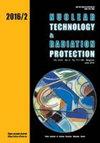Comparative study of the MeV ion channeling implantation induced damage in 6H-SiC by the iterative procedure and phenomenological CSIM computer code
IF 0.9
4区 工程技术
Q3 NUCLEAR SCIENCE & TECHNOLOGY
引用次数: 0
Abstract
Due to its unique material properties, such as extreme hardness and radiation resistance, silicon carbide has been used as an important construction material for environments with extreme conditions, like those present in nuclear reactors. As such, it is constantly exposed to energetic particles (e.g., neutrons) and consequently subjected to gradual crystal lattice degradation. In this article, the 6H-SiC crystal damage has been simulated by the implantation of 4 MeV C3+ ions in the (0001) axial direction of a single 6H-SiC crystal to the ion fluences of 1.359 1015 cm-2, 6.740 1015 cm-2, and 2.02 1016 cm-2. These implanted samples were subsequently analyzed by Rutherford and elastic backscattering spectrometry in the channeling orientation (RBS/C & EBS/C) by the usage of 1 MeV protons. Obtained spectra were analyzed by channeling simulation phenomenological computer code (CSIM) to obtain quantitative crystal damage depth profiles. The difference between the positions of damage profile maxima obtained by CSIM code and one simulated with stopping and range of ions in matter (SRIM), a Monte Carlo based computer code focused on ion implantation simulation in random crystal direction only, is about 10%. Therefore, due to small profile depth shifts, the usage of the iterative procedure for calculating crystal damage depth profiles is proposed. It was shown that profiles obtained by iterative procedure show very good agreement with the ones obtained with CSIM code. Additionally, with the introduction of channeling to random energy loss ratio the energy to depth profile scale conversion, the agreement with CSIM profiles becomes excellent.采用迭代法和现象学CSIM计算机代码对MeV离子通道注入致6H-SiC损伤的比较研究
由于其独特的材料特性,如极高的硬度和抗辐射性,碳化硅已被用作极端条件环境的重要建筑材料,例如核反应堆。因此,它不断地暴露在高能粒子(例如中子)中,从而使晶格逐渐退化。本文通过在单个6H-SiC晶体(0001)轴向注入4 MeV的C3+离子,模拟了6H-SiC晶体在1.359 1015 cm-2、6.740 1015 cm-2和2.02 1016 cm-2离子影响下的损伤。随后,利用1 MeV质子在通道取向(RBS/C和EBS/C)上对这些注入样品进行卢瑟福和弹性后向散射光谱分析。利用通道模拟现象学计算机代码(CSIM)对得到的光谱进行分析,得到定量的晶体损伤深度分布图。CSIM代码与基于蒙特卡罗的仅关注随机晶体方向离子注入模拟的停止和物质中离子范围(SRIM)模拟的最大损伤轮廓位置相差约10%。因此,由于晶面深度偏移较小,提出了用迭代法计算晶体损伤深度轮廓的方法。结果表明,用迭代法得到的剖面与用CSIM代码得到的剖面具有很好的一致性。此外,引入了随机能量损失比通道和能量深度剖面尺度转换,使其与CSIM剖面的一致性变得很好。
本文章由计算机程序翻译,如有差异,请以英文原文为准。
求助全文
约1分钟内获得全文
求助全文
来源期刊

Nuclear Technology & Radiation Protection
NUCLEAR SCIENCE & TECHNOLOGY-
CiteScore
2.00
自引率
41.70%
发文量
10
审稿时长
6-12 weeks
期刊介绍:
Nuclear Technology & Radiation Protection is an international scientific journal covering the wide range of disciplines involved in nuclear science and technology as well as in the field of radiation protection. The journal is open for scientific papers, short papers, review articles, and technical papers dealing with nuclear power, research reactors, accelerators, nuclear materials, waste management, radiation measurements, and environmental problems. However, basic reactor physics and design, particle and radiation transport theory, and development of numerical methods and codes will also be important aspects of the editorial policy.
 求助内容:
求助内容: 应助结果提醒方式:
应助结果提醒方式:


